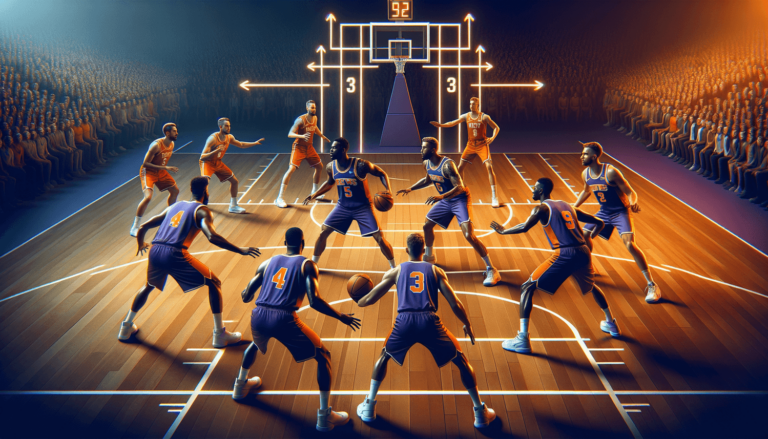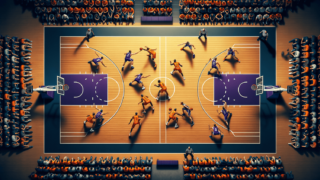
Welcome to the world of basketball strategies, where today we’re diving into the intriguing concept of the 3-3 Zone Defense! Those who eat, sleep, and breathe basketball already know that defense is just as crucial as offense, and the 3-3 Zone Defense is one of those unconventional but effective tactics that keeps opponents on their toes. If you’re eager to expand your strategic knowledge and really sink your teeth into the sport, then you’ve come to the right place. So buckle up, as we explore the ins and outs of the 3-3 Zone Defense, revealing its nuances and showing you why it’s a go-to option for savvy basketball minds. After all, who doesn’t love discovering a new ace up their sleeve?
What’s a 3-3 Zone Defense in Basketball?
A 3-3 Zone Defense in basketball is a specialized defensive strategy that positions three players up front, close to the three-point line, and three players behind them, forming a second line of defense closer to the basket. Utilized to counter outside shooting threats and protect against penetration, this defensive formation relies on exceptional communication, quick rotations, and strong teamwork to effectively limit the opposing team’s scoring opportunities.
Breaking Down the 3-3 Zone Defense
Before diving into the nitty-gritty of the 3-3 Zone Defense, it’s essential to understand some basic principles. Basketball defensive strategies can usually be classified into two main categories: man-to-man and zone defenses. In man-to-man defense, each player is responsible for guarding a particular opponent, while zone defenses involve players guarding specific areas of the court rather than individual opponents.
The 3-3 Zone Defense is designed to counter teams with strong outside shooters and disrupt opponents’ offensive flow. Let’s delve into the foundation of this unique approach and break down its components to better grasp its effectiveness on the court.
Positioning and Formation
As the name suggests, the 3-3 Zone Defense sets up three players near the three-point line and three players behind them. This formation creates a hexagonal shape on the court, resulting in the following position assignments:
- Point: Located at the top of the three-point arc, this player’s primary responsibility is to defend the ball handler and prevent penetration into the lane.
- Wings: Positioned on either side of the Point, these players cover the area from the three-point line to the baseline. They are tasked with covering the corners, defending the wings, and preventing sharp outside shooters from getting open looks.
- Low Block: Situated on either side of the key near the baseline, these two players form the second line of defense. Their primary job is to protect the paint, contest shots near the rim, and secure rebounds.
- Rim Protector: Positioned in the middle of the key, this player serves as the anchor of the defense. Their responsibilities include protecting the rim, contesting shots, and securing rebounds.
3-3 Zone Defense Principles and Rules
To effectively employ the 3-3 Zone Defense in basketball, players must adhere to a set of basic principles and rules. These guidelines ensure smooth rotations, strong communication, and effective disruption of the opposing team’s offensive attack. Here are the key principles and rules to follow:
Responsibility Areas
Each player is defined by an area of the court that they are responsible for defending. The point covers the top of the arc, the wings are assigned to their respective sides from the three-point line to the baseline, and the low block players are responsible for the baseline areas closest to the key. The rim protector must defend the middle of the key and block shots when necessary.
Quick Rotations
Efficient communication and quick rotations are crucial for success in the 3-3 Zone Defense. When the ball moves, players should anticipate passes, slide into position to prevent easy shots, and be ready to confidently switch between areas of responsibility. Synchronized rotations force opponents to face more contested shots, increasing the chances of missed field goals and turnovers.
Basketball Communication
Effective communication is the backbone of any solid defense, and the 3-3 Zone Defense is no exception. Players need to constantly communicate with each other about the positioning of their opponents and the ball. Communicating effectively allows for proper rotations, switches, and successfully contesting shots.
Proxy Defense
A proxy defense can be implemented within the 3-3 Zone Defense to apply additional pressure on ball handlers and disrupt passing lanes. This principle involves one player stepping up to guard the ball while the teammates behind them temporarily shift to cover empty spaces. Once the ball handler is sufficiently pressured or deterred, the proxy defender returns to their original position.
Advantages of the 3-3 Zone Defense
Now that we have a solid understanding of the 3-3 Zone Defense’s principles and rules, let’s take a look at some of the advantages and reasons why teams incorporate this defensive strategy into their game plan.
Disrupting Opponent’s Offensive Rhythm
As teams become more reliant on three-point shooting, the 3-3 Zone Defense serves as an effective means of combatting this strategy. By positioning three defenders along the three-point arc, opponents are forced to find alternative ways to score. This disruption serves to stifle their rhythm and prevents them from taking easy, open shots from beyond the arc.
Protecting the Paint
The 3-3 Zone Defense balances perimeter defense with a strong interior presence, maintaining tight protection in the paint. The rim protector and low-block defenders make it difficult for opposing big men to establish a deep presence in the post. Since fewer open layups and dunks are available, the opposing team must rely on lower-percentage shots from beyond the arc or mid-range jumpers.
Rebounding and Transition Defense
The 3-3 Zone Defense’s unique formation puts it in an excellent position to secure defensive rebounds, with multiple players in the vicinity of the basket. Rebounding can lead to fast-break opportunities, resulting in easy points on offense. Additionally, the compact nature of the zone allows for a seamless transition into a stout transition defense – crucial for preventing quick baskets from the opposition.
Keys to Successfully Implementing a 3-3 Zone Defense
While the advantages of the 3-3 Zone Defense are evident, translating these benefits into real-world results requires attention to detail and a strong commitment from the entire team. Here are some key factors to consider when implementing a 3-3 Zone Defense:
Incorporate Detailed Drills
Integrating the 3-3 Zone Defense into your team’s repertoire requires an array of specialized drills. These exercises should emphasize proper positioning, rotation, and communication. Some examples of useful drills include:
- Shell Drill: This drill focuses on maintaining defensive positioning and rotating efficiently to cover different areas of responsibility.
- Zig-zag Drill: Tailored to the 3-3, this drill teaches players how to slide between responsibility areas while maintaining balance and a low center of gravity.
- Scramble Drill: Simulating game-like situations, this drill tests players’ communication and ability to react quickly to ball movement.
Instill the Importance of Communication
Remind your players that effective communication is indispensable when executing the 3-3 Zone Defense. Encourage them to talk continuously on the court, utilizing clear and concise instructions when positioning and reacting to plays. Over time, this mentality will become ingrained within the team, resulting in improved defensive performance.
Adapt and Adjust
Lastly, be prepared to adapt and adjust the 3-3 Zone Defense to match the strengths and weaknesses of your opponents. As the game progresses, use your timeouts and in-game adjustments to address any issues that arise, fine-tuning your defense to best neutralize your opponents’ offensive threats.
By understanding and implementing the 3-3 Zone Defense effectively, basketball teams from all levels can benefit from this creative approach to defending the court. With the right commitment, practice, and communication, your team will be well on its way to mastering this unique and disruptive defensive strategy.
Familiarizing With Other Zone Defenses
To better comprehend the nuances of the 3-3 Zone Defense, it’s crucial to familiarize yourself with other common zone defenses in basketball. Knowing their strategies, formations, and principles will give you an edge when it comes to understanding when and where the 3-3 Zone Defense can be best employed.
2-3 Zone Defense
The 2-3 Zone Defense is one of the more popular zone defenses used at various levels of basketball. Its formation places two players at the top of the key and three players along the baseline. This defense prioritizes protecting the paint while giving up low-percentage shots along the three-point line. Understanding the strengths and weaknesses of the 2-3 Zone Defense can help you identify the advantages of the 3-3 Zone Defense in certain situations, especially when facing proficient three-point shooting teams.
1-3-1 Zone Defense
The 1-3-1 Zone Defense is another strategic defensive framework that positions one player at the top, three players in a line through the center of the court, and one player beneath the basket. This defense encourages defensive traps and intense pressure on ball handlers. The 1-3-1 Zone Defense addresses key weaknesses prevalent in other zone defenses, such as vulnerability to cross-court passes or the lack of pressure on opposing guards. Comparing the 1-3-1 and the 3-3 Zone Defense will give you a better grasp of the situations where each defense may be preferable depending on your team’s skill set and your opponents’ tendencies.
Combining Man-to-Man and Zone Concepts
As you progress in your understanding of zone defenses, consider the possibilities of hybrid defenses that combine both man-to-man and zone principles. The fusion of these defensive approaches creates new, unique strategies, such as the Box-and-One and Triangle-and-Two defenses. These hybrid defenses blend specific man-to-man matchups with traditional zone responsibilities, presenting new challenges for opposing offenses.
Observing Professional and Collegiate Teams
Another remarkable way to improve your understanding of the 3-3 Zone Defense is to observe professional and collegiate teams in action. By watching film breakdowns, game highlights, and full-length matches, you can analyze how different coaches and players employ the 3-3 Zone Defense in real-game situations. Studying these examples will enable you to identify potential adjustments and best practices for your team’s implementation of the 3-3 Zone Defense.
Defense Wins Championships
In conclusion, defense remains a foundational element in the success of any basketball team. Mastering an unconventional and effective strategy like the 3-3 Zone Defense can provide your team with a unique advantage over the opposition. So, don’t shy away from embracing this disruptive defensive approach, and embark on the journey to transform your team’s on-court performance.
FAQs on 3-3 Zone Defense
Are you craving even more insights into the 3-3 Zone Defense? We’ve got you covered with a frequently asked questions (FAQ) section! Explore these responses to some of the most commonly asked questions on this defensive strategy, and become even more informed about this fascinating basketball tactic.
1. How is 3-3 Zone Defense different from other zone defenses?
The 3-3 Zone Defense distinguishes itself by stationing three players on the perimeter and three players in the paint to prevent both outside shots and penetration. It emphasizes strong communication, quick rotations, and coordinated teamwork to counteract offensive threats.
2. What level of basketball is 3-3 Zone Defense best suited for?
The 3-3 Zone Defense is effective for various levels of basketball, from youth leagues to professional play. It’s particularly well-suited for countering opponents that heavily rely on three-point shooting.
3. How do players rotate in the 3-3 Zone Defense?
Players rotate by sliding between their areas of responsibility and adjusting as the ball moves. Effective rotations require anticipation, communication, and swift movement to ensure proper positioning and contesting of shots.
4. Can a team mix the 3-3 Zone Defense and man-to-man defense during a game?
Yes, incorporating a combination of defensive schemes, including the 3-3 Zone Defense and man-to-man defense, helps create various looks for the opposition, making it difficult for them to adapt and establish offensive rhythm.
5. What type of players excel in a 3-3 Zone Defense?
Players who excel in a 3-3 Zone Defense are versatile, agile, and possess excellent communication skills. They should also have the ability to anticipate ball movement, rotate swiftly, and adapt to the challenges presented by opposing offenses.
6. What are the main weaknesses of a 3-3 Zone Defense?
Some weaknesses of a 3-3 Zone Defense include vulnerability to quick ball movement, difficulty in matching up during rotations, and potential lapses in rebounding due to defenders being spread out in the formation.
7. How effective is the 3-3 Zone Defense against a dominant post player?
The 3-3 Zone Defense can be effective against dominant post players, as it features a rim protector and additional help defense in the paint. This forces opposing post players to pass the ball or take lower-percentage shots.
8. Can a team adjust the 3-3 Zone Defense throughout the game?
Yes, a team can and should make adjustments to the 3-3 Zone Defense based on the specific strengths and weaknesses of the opposing team. Adjustments can be made to tighten rotations, apply more pressure on shooters, or protect the paint more effectively.
9. Are there any notable teams that have successfully utilized the 3-3 Zone Defense?
While there may not be any widely known examples of teams primarily utilizing a 3-3 Zone Defense, coaches have experimented with it to varying degrees of success. Each team’s application tends to be unique, adapting the defense based on their personnel and the strategic aims of the game.
10. Can a team that predominantly uses man-to-man defense seamlessly transition to a 3-3 Zone Defense?
Yes, a team that predominantly uses man-to-man defense can transition to a 3-3 Zone Defense with proper practice and emphasis on its unique principles such as positioning, rotation, and communication. Adapting to this system may take some time but can be a valuable addition to a team’s defensive repertoire.
Featured Posts
- No pillar pages found.





